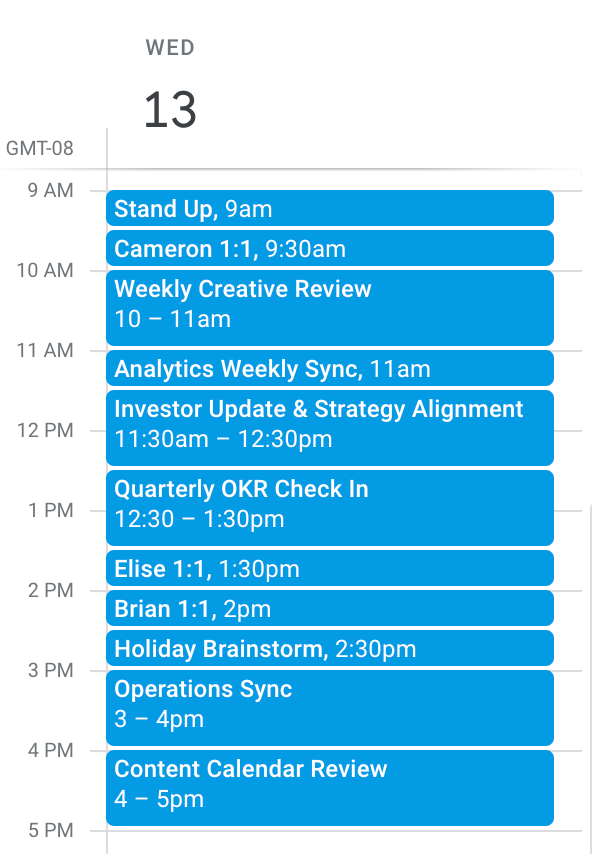We’re taking a short break from regular programming for “from Our Perspectives” – essays from internal team members that share a personal perspective on internal project management. This week, we’re featuring a perspective from Brandon on how to reimagine meetings to make them more effective.
There’s a special type of dread that emerges when you check your calendar and see a day filled with back-to-back-to-back meetings. Could some of these be emails or Looms? What problems are at the heart of each of these meetings, and am I truly needed for all of them? It’s time we dug into why so many meetings fall short, and imagine a better path forward using a generalist mindset.
What’s at stake here isn’t just making meetings incrementally more efficient, it’s protecting your source work. Priya Parker, author of The Art of Gathering, describes source work as the essential activities or core tasks that are central to an individual’s professional identity, expertise, and unique contributions, in other words, your work product. If you’re a specialist founder building a tater-tot empire, that could mean experimenting in the kitchen to dial in the perfect recipe for your tater-tots. If you’re a generalist founder, it could be reimaging the marketing and branding of your potato-based brand to reach a whole new audience. If you’re lost on the specialist vs. generalist founder distinction or the tater tot reference, see this previous how We Do article on how generalists help generalist founders. Regardless of what the source work looks like, a founder’s capacity to prioritize it is invaluable to the organization because it unlocks creative energy and authenticity. Trying to squeeze in source work on the edges of a schedule bogged down with touchbases and 1:1s is a recipe for withering on the vine.
Startups often fall into the trap of recurring, unfocused meetings with unclear goals. At one point, these meetings were drawn up to solve a problem, but while priorities change quickly, meetings tend to resist adapting in response. Parker argues that meetings can and should be treated as intentional gatherings. By making the intention of the meeting clear, we can evaluate whether it is still serving its purpose, or if it needs to be transformed. Adding the purpose to the meeting description, restating it at the start of the meeting, and including it in follow-up notes are all ways to reinforce the intention.
You can take this further by disallowing recurring meetings altogether, requiring the meeting host to clearly state an intention and a guest list for each gathering and take the time to send an invite for each one. Here the added friction may actually be a net positive, encouraging thoughtful pre-meeting planning and resulting in a survival-of-the-fittest evolution for the meetings on your calendar. This type of meeting management lands squarely in the wheelhouse of a generalist who may be uniquely skilled at determining who truly needs to be gathered to fill in the gaps and solve the problems at hand.
The caveat to all this critique about reimagining meetings is that it can be messy. Sometimes a meeting solves one problem but creates another. Sometimes it needs to be weekly, but sometimes it can be monthly. Sometimes it needs to be 15 mins, sometimes 1hr 15. The key to navigating this messy process also happens to be the theme of what we’re currently diving into over at the oAT Collective: communication. Clear communication and feedback are the lifeblood of a thriving meeting, but it takes significant time and energy to be thoughtful about both these things. Here, again, is where a generalist can thrive. Generalists can take the lead on collecting feedback and iterating on a meeting because they have the perspective to see the forest through the trees, while also being in the weeds enough to keep things grounded in reality. For example, a weekly cross-functional meeting where team leaders share updates could be transformed into a working session where problems are surfaced and then groups split into breakout rooms based on whose expertise is needed. A generalist with cross-functional visibility is the ideal facilitator for these kinds of meeting experiments. They also have the perspective necessary to call out when a meeting might be more beneficial for everyone to be pivoted to an async collaboration.
For one last bit of meeting-makeover wisdom, we turn again to Priya Parker, who reminds us that, “Meaning making disproportionately happens at the last 5% of an experience.” Parker encourages us to extend beyond a focus on next steps and to-dos, by also digging for what people are getting out of the meeting. For example, you can ask people to write in the chat one thing they took away from the meeting that is going to change how they make decisions moving forward and one thing they would like to see in the next iteration of the meeting. Encouraging this type of reflection acknowledges that the group has its own culture that welcomes trust and open communication. These are defining characteristics of thriving teams, and a thriving team opens up a leader to have a calendar that looks more like this:
Writer: Brandon







Love this piece- really nails how meetings can suck the life out of your day if they’re not intentional. The focus on reclaiming “source work” time is spot on. Also, the idea of making meetings evolve with feedback is solid.. that feels like a simple tweak that could actually change team dynamics for the better. Great stuff Brandon!